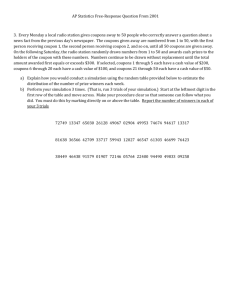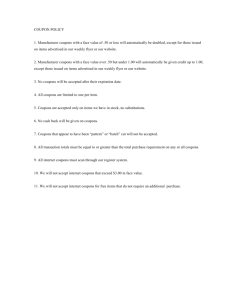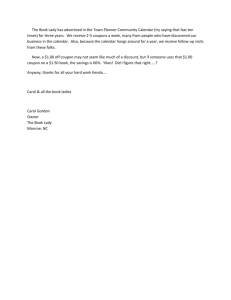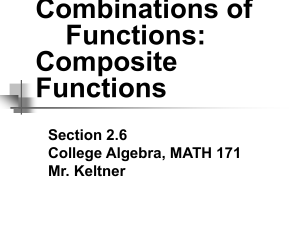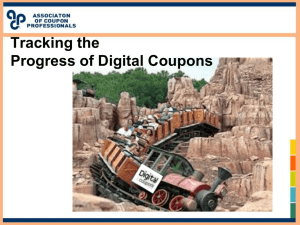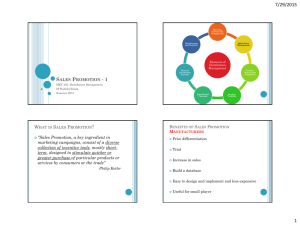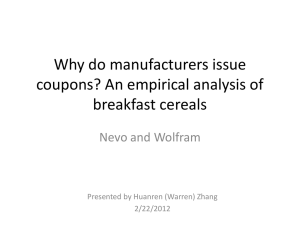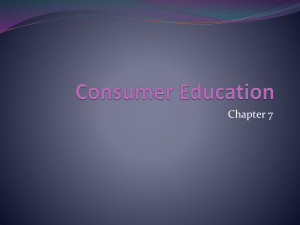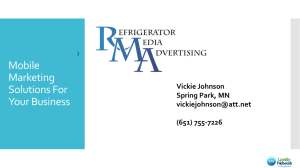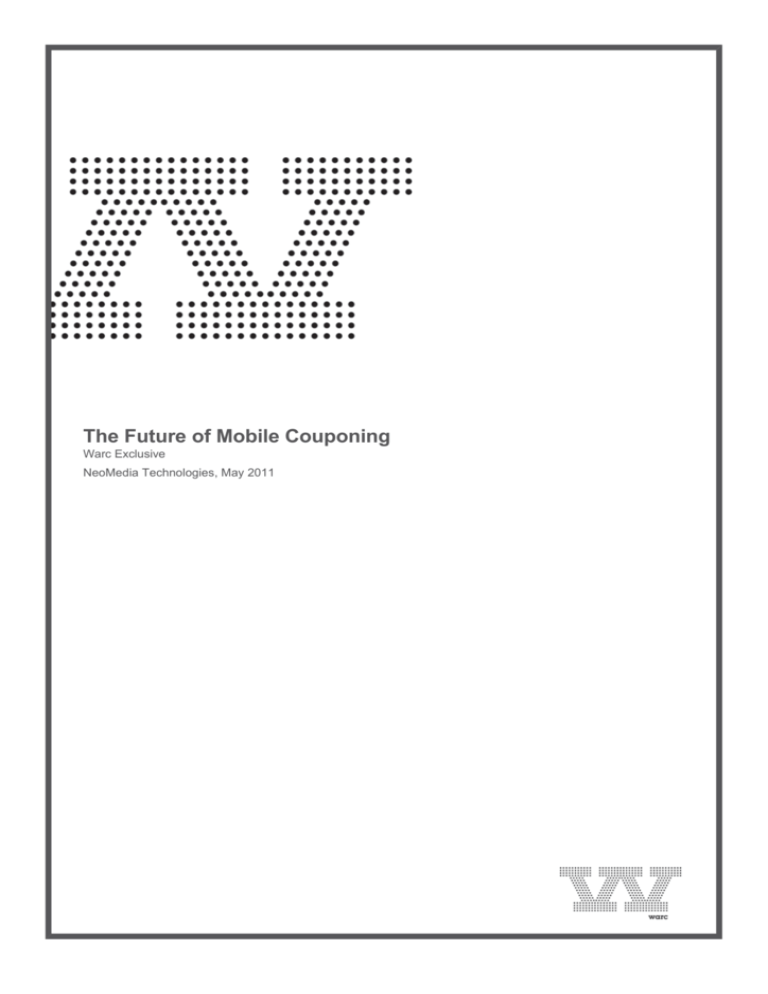
The Future of Mobile Couponing
Warc Exclusive
NeoMedia Technologies, May 2011
Title:
Source:
Issue:
The Future of Mobile Couponing
Warc Exclusive
NeoMedia Technologies, May 2011
The Future of Mobile Couponing
Smart mobile couponing is a new form of mobile couponing that creates an opportunity for retailers, stores, packaged goods
companies and marketers to communicate directly with the consumer.
INTRODUCTION
In marketing, a coupon is a ticket or document that can be exchanged by a consumer for a financial discount or rebate when
purchasing an applicable product.
Coupons provide consumers with purchase incentives, offering them financial savings on goods and services or encouraging
them to try something new. Coupons are a practical and successful marketing strategy to drive awareness, loyalty, repeat
purchase and footfall and/or site traffic.
As mobile devices have ushered in a new digital lifestyle for millions of consumers, marketers have sought new ways to
integrate coupons into these hi-tech devices. As such, coupons can now be distributed and redeemed via the consumer's
mobile device, presenting brands and agencies with a new interactive landscape through which to engage their target
consumer.
For consumers, mobile coupons are appealing as they (1) provide a high degree of convenience – no need to clip and
organise; and (2) are "green" in that they help reduce paper waste and preserve the environment.
Mobile coupons can be targeted and tailored to the consumer, thus making them very valuable to a brand, over traditional
paper coupons. They also provide a 'push to purchase' element within a marketing campaign, offering higher redemption rates
– nearly ten times that of coupons delivered via print or mail1 – and greater cost-efficiency. As such, mobile coupons have
become a key element in a brand's mobile marketing mix, creating added value for both the brand and consumer alike.
EVOLUTION OF THE COUPON – A BRIEF HISTORY
Companies have used coupons to market their products to mass audiences for over 110 years. In 1887, Atlanta businessman
and co-owner of Coca-Cola, Asa Candler, used handwritten tickets for a free glass of the soft drink. Looking for a name for this
new marketing tool, he turned to the French verb couper, meaning 'to cut'2 . The coupons that followed Coca-Cola's initial
innovation represent the first generation of coupons: those that are manually printed, clipped, and processed.
As technology and sales evolved with the proliferation of barcodes in the 1980s and the internet in the 1990s, coupons began
to evolve in terms of shape and style. Retailers began including barcodes on the coupon face, offering printable coupons that
consumers could download from the internet, and simplifying the redemption process by allowing coupons to be electronically
Downloaded from warc.com
2 scanned at the point of redemption. These signify the second generation of couponing: those that are manually printed and
clipped, but digitally processed at the point-of-sale (POS).
Today, with the popularity of smartphones and the mobile internet, we are seeing more and more mobile applications, or
'apps', and mobile sites that aggregate and deliver geo-targeted coupons from nearby retailers. These apps and mobile
coupon sites allow consumers to enter their preferences and be notified of relevant deals. These types of mobile coupons are
the third generation: those that are both digitally accessed and processed.
The success of third generation coupons relies entirely on pull marketing mechanisms, meaning that the consumer has
complete control over what coupons he or she accesses. While this type of marketing has had some notable success, there is
no meaningful opportunity for the brand to create an on-going dialogue or reward consumers for their continued loyalty. The
core relationship is between the consumer and the aggregator rather than directly with a particular brand. As a result of this,
and enabling brands to create a direct interaction with their target consumer, a fourth generation of coupon has arrived – the
smart mobile coupon.
ADVANTAGES OF SMART MOBILE COUPONING
This fourth generation of couponing combines the benefits of pulled coupons and offers – allowing the consumer to choose
when and where to engage – with a new push component. Smart mobile coupons can enable targeted, traceable and
personalised coupons, allowing brands to provide an opt-in opportunity to consumers so that they can continue to send
relevant coupons.
Compared with previous generations of the coupon, smart mobile coupons create a number of new opportunities for brands
and retailers to enter into a direct dialogue with consumers on a one-to-one basis, driving sales, repeat purchase, customer
loyalty and marketing ROI. Some of the advantages of smart mobile coupons include:
1. A full end-to-end interactive consumer experience
For consumers, opting into a mobile programme is a way to receive exclusive offers from their favourite merchants
targeted to their particular needs – anywhere and at any time – providing convenience, flexibility, safety and security.
Downloaded from warc.com
3 Smart mobile coupons cannot be lost and do not take up space in the wallet. They also enhance the consumer's
shopping experience by allowing them to engage in marketing campaigns and be rewarded in return for their affinity and
loyalty.
2. A two-way personalised communication tool
Smart mobile couponing allows brands to reach a highly targeted audience with the ability to personalise and
individualise offers with direct marketing messages, unlike mobile apps which are more general. Two-way communication
means engaging with the consumer on a personal level and building stronger customer relationships, while addressing a
customer audience individually and specifically.
3. 100% target reach and usage
SMS and MMS messages currently enjoy a near-100% open rate, compared to mobile applications which require a
smartphone in order to download and use them. Although a growing market, smartphones accounted for just 23% of all
new handsets sold worldwide in 20103, while research has shown that although consumers may install around 20 apps
on their device, only four to six are used on a consistent basis4. Smart mobile coupons may represent a better option for
brands and retailers when they consider that consumers are not going to keep downloading and using an unlimited
number of mobile apps and that their offers also stand in competition with others within the same couponing application.
4. Cost-effective
Costs for smart mobile couponing campaigns are minimal as mobile delivery reduces distribution costs significantly by
eliminating printing and shipping costs. The only costs generated are for SMS or MMS sent to a targeted and engaged
audience.
5. Real-time analytics and tracking
Smart mobile couponing allows brands to achieve a better view of the customer's activity in retail environments, as it is
highly traceable due to the consumer's ability to respond directly and instantly by mobile phone. Data on redemptions,
product interests, purchase habits and preferences can be collected for future target group selections and customer
relationship management (CRM) activity. Results can be seen quickly and offers can be adapted according to the results
with minimal spend and with greater success. The ability to target specific customers helps increase effectiveness and
reduce overall costs.
6. Replacing the loyalty card
Smart mobile couponing provides the ability to create a brand affinity and instantly reward consumers at the point-of-sale.
By gaining insight into who, when and how a consumer is interacting with a brand and a product, opt-in for mobile loyalty
programmes can easily be captured at the same time, replacing the bonus or loyalty card with the mobile device.
Consumers will be able to receive exclusive offers and great deals and redeem their points and bonuses simply by using
the mobile phone – eliminating the costs for retailers to produce, issue and manage plastic loyalty cards.
7. Cross-marketing programmes and co-promotions
Smart mobile couponing can be combined with cross-promotions within co-marketing programmes to advertise special
brand or third-party offerings and attract more consumers for a specific product. Retailers can advertise their own brands,
and partners can successfully expand through the existing customer base.
UNDERSTANDING THE CONSUMER EXPERIENCE
Downloaded from warc.com
4 Consumers can receive and use a mobile coupon almost anywhere. Smart mobile coupons may be delivered to the consumer
in one of two ways: messaging (SMS/MMS) or via the mobile web. To better understand the user experience, consider these
three 'use cases':
Use Case 1: Coupons delivered via messaging service
Consumer A sees a billboard offering a compelling product discount. He or she then texts the keyword to the short code
mentioned on the billboard and immediately the mobile coupon is delivered in the form of a 2D barcode to his or her mobile
phone via a return MMS.
Use Case 2: Coupons delivered via the mobile web
Consumer B is shopping and sees a sign attached to a store shelf with a 2D barcode included on the promotional piece. He or
she then uses the barcode-reading application on his or her phone to scan the barcode, connects instantly to the brand's
promotional site and accesses the mobile coupon on the mobile phone screen, also as a 2D barcode.
Use Case 3: Coupons delivered via experience terminals
Consumer C uses the experience terminals to participate in a brand's mobile marketing campaign and take advantage of the
coupon's offer. He/she enters his/her mobile phone number and receives a personalised barcoded-coupon via SMS to be
redeemed at the checkout. (Experience terminals are kiosks or displays that combine printer, touch screen, keypad and
barcode scanner. Placed at the point-of-sale or point-of-interest, they are used to read codes from the mobile phone screen,
print vouchers and execute transactions. With an LCD touch-screen and live-stream capability, the experience terminal can
display targeted content and branded messages, as well as advertise co-branded programmes and playback video trailers in
order to grab consumers' attention and gain their interest while they are shopping, and convert them to buy. Experience
terminals are also used for CRM to generate a relevant user database with profile and scanning/usage information that can be
used to send personalised mobile coupons and offers.)
UNDERSTANDING THE TECHNOLOGY
Smart mobile coupons are created and generated via a hosted backend service software (SaaS), and then sent directly to the
consumer's mobile phone as an SMS or MMS, or accessed via a mobile website. They appear on the phone screen in the
form of an individualised 2D barcode that can be scanned at the point-of-sale.
Experience terminals and scanners placed at the point of sale or point of interest are used to decode the mobile coupon from
the phone's screen. The validity of the mobile coupon is verified against the store or service provider's central database. This
ensures that the voucher is redeemed only once and, in the case of a valid coupon, will be immediately deducted from the total
purchase price.
Downloaded from warc.com
5 Loyalty programmes can also be developed and integrated into the mobile couponing experience to optimise customer
satisfaction and build goodwill with the target audience once consumers have opted in to the mobile communication. The
plastic card issued when subscribing to a loyalty or affinity programme is easily substituted by the mobile phone. Information
about the customer's behaviour and buying patterns are collected every time the mobile loyalty card is used, while the
customer remains unencumbered with yet another piece of plastic.
CASE STUDIES
McDonald's
McDonald's was the first restaurant chain to use mobile couponing successfully in Germany. McDonald's wanted to create a
cutting-edge means of connecting with customers that had the potential to drive real business results. Furthermore, it wanted
to create brand awareness by using a mechanic that positioned McDonald's as an innovative and forward-looking brand. It
developed a mobile couponing campaign: consumers participating in the McDonald's mobile couponing programme received
special discounts in the form of a 2D barcode that was sent to their mobile phone as a text message. The scanning systems
deployed in several McDonald's restaurants throughout Germany were used to read the coupons directly from the mobile
phone display and to then issue a receipt to the participant. These were redeemed at the register as usual and used as credit
towards orders. At the same time, a database ensured that only a personal coupon quota could be redeemed. Within one year,
more than 10,000 participants had used this McDonald's service. Over 74% participated multiple times and redeemed more
than one of the coupons. The brand achieved a remarkably strong response rate of up to 29%, as well as new CRM data that
delivered campaign feedback with user profile data and usage information.5
(See more here)
H&M
Swedish fashion retailer H&M created a promotional campaign for the opening of new shops in Germany, based around
mobile couponing. 120,000 registered members of a web community received a mobile coupon, offering them a free H&M Tshirt when presenting the code to be scanned at the new H&M shops in Berlin, Hamburg and Cologne. Using MMS
technology, the mobile coupons were sent as a unique and encrypted 2D code to the user's mobile phone. Information like
store name, opening date and coupon value were not only encrypted in the code but also displayed on the mobile phone
screen. To support this special limited-time marketing campaign, the 2D code also contained an expiration date. When
presented at the register in the new stores, the scanning solution, connected to the store database via GPRS communication,
decoded the mobile coupon from the mobile phone screen and checked its validity. Once the code was validated, the
customers received their free T-shirt. Within 48 hours, 78% of the addressed members in Berlin had reacted to the MMS. By
opening time on the day of the store's launch, more than 100 customers were queuing up to redeem the offer. Two hours after
Downloaded from warc.com
6 the shop opened, all 2,000 T-shirts had been given away.6
(See more here)
FOOTNOTES
1. Mobile coupon redemption rates to rise this year, Mobile Commerce Daily, 21 April, 2010,
http://www.mobilecommercedaily.com/ 2010/04/21/mobile-coupon-redemption-rates-to-rise-this-year.
2. http://www.ilovecouponmonth.com/resources/history-of-coupons.htm
3. http://www.ad-hoc-news.de/research-and-markets-smartphone-futures-2011-2015--/de/News/21821359
4. http://www.mobilemarketingwatch.com/mobile-apps-may-be-reaching-a-saturation-point-sms-still-reigns-supreme-5920/
5. All results from 12snap http://www.12snap.com/index.php?page=mcdonalds; http://mobmarketing.wordpress.com/
2008/08/06/mcdonald%E2%80%99s-12snap-und-gavitec-gehen-neue-wege-in-der-kundenbindung/
6. All results from YOC AG http://group.yoc.com/
ABOUT NEOMEDIA
NeoMedia Technologies, Inc. is the global market leader in 2D mobile barcode technology and infrastructure solutions that
enable the mobile barcode ecosystem world-wide. Its technology platform transforms mobile devices with cameras into
barcode scanners, enabling a range of practical and engaging applications including consumer oriented advertising, mobile
ticketing and couponing, and business-to-business commercial track and trace solutions.
NeoMedia's suite of products, services and extensive IP portfolio means it is the only provider able to offer customers a
comprehensive end-to-end mobile code solution. NeoMedia's current customers include handset manufacturers, platform
providers, brands and agencies looking to offer pioneering mobile barcode solutions to their customer base.
NeoMedia's product portfolio includes: mobile barcode management & infrastructure solutions, barcode reader solutions,
mobile coupon & affiliate marketing, mobile ticketing & POS integration and IP licensing. Learn more at www.neom.com.
NeoMedia Technologies, Inc.
Two Concourse Parkway, Suite 500
Atlanta, GA 30328
T +1 678 638 0460
F +1 678 638 0466
NeoMedia Europe AG
Jens-Otto-Krag-Straße 11
52146 Würselen
Germany
T +49 2405 49922-0
F +49 2405 49922-99
info@neom.com
www.neom.com
Downloaded from warc.com
7 © Copyright Warc 2011
Warc Ltd.
85 Newman Street, London, United Kingdom, W1T 3EX
Tel: +44 (0)20 7467 8100, Fax: +(0)20 7467 8101
www.warc.com
All rights reserved including database rights. This electronic file is for the personal use of authorised users based at the subscribing company's office location. It may not be reproduced, posted on intranets, extranets
or the internet, e-mailed, archived or shared electronically either within the purchaser’s organisation or externally without express written permission from Warc.
Downloaded from warc.com
8

